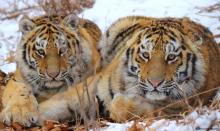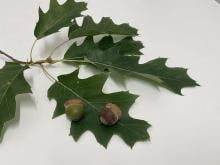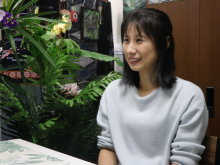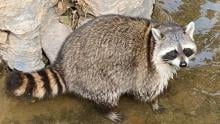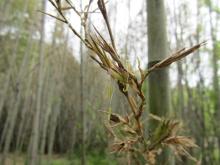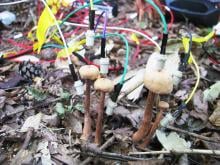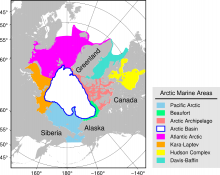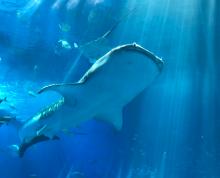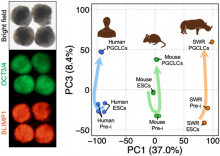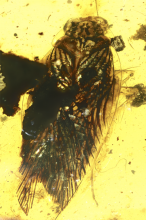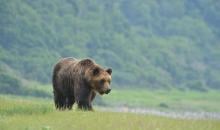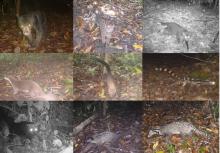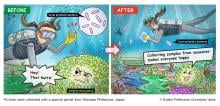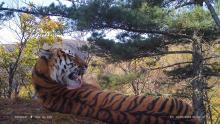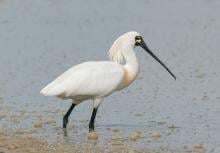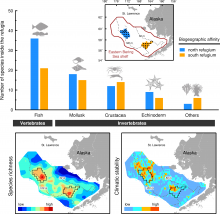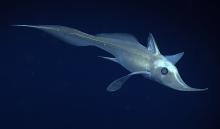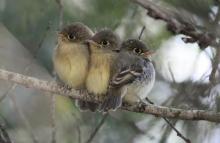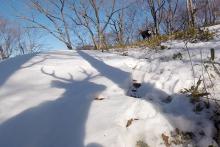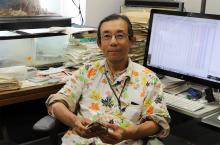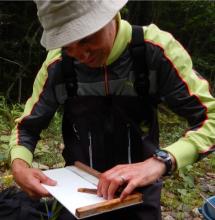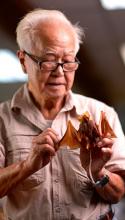Biology Ecology
News
24 Apr 2024
The recently concluded Sustainable Finance for Tiger Landscapes Conference convened tiger range countries, private and public sector donors, international development agencies, the Tiger Conservation Coalition, and other conservation organisations to discuss innovative solutions to sustainably finance tiger landscape conservation.
22 Feb 2024
The effects of a phenomenon called tree masting on ecosystems and food webs can be better understood thanks to new theoretical models validated by real world observations.
21 Nov 2023
Out of this living laboratory emerged unexpected insights on coexistence from an “unusual” source.
04 Sep 2023
In recent years, an emerging zoonotic pathogen called E. albertii, transmitted by wild animals such as raccoons, has garnered attention due to its remarkable similarities to several strains of Escherichia coli (E. coli), including O157, and its potential to cause severe illness, particularly in children. A research group at Osaka Metropolitan University has developed a novel culture medium that allows for the selective cultivation of E. albertii from raccoon fecal samples. This enabled the successful isolation of E. albertii even from samples with very low quantities of this bacterium. Their findings are expected to further elucidate the bacteriological characteristics of E. albertii and to contribute to the control of foodborne illnesses.
29 Aug 2023
A long-lived monocarpic species of bamboo, Phyllostachys nigra var. henonis, only flowers once every 120 years before it dies. The upcoming flowering event for this species does not bode well for its continued long-term survival, as most flowers are not producing viable seeds.
19 May 2023
Mushrooms 🍄get chattier after rainfall 🌧️, Two-organ chip answers fatty liver questions, History maps 🗺️vs future simulations, Restoring vision in blindness. Plus in our blog: Myanmar: Through eyes of leadership. Read all in the latest Editor's Choice.
28 Apr 2023
Certain types of fungi can communicate with each other via electrical signals. But much remains unknown about how and when they do so. A group of researchers recently headed to the forest to measure the electrical signals of Laccaria bicolor mushrooms, finding that their electrical signals increased following rainfall.
04 Apr 2023
Marine predators have expanded their ranges into the Arctic waters over the last twenty years, driven by climate change and associated increases in productivity.
28 Mar 2023
A group including Osaka Metropolitan University researchers discovered that the rhodopsin—a protein in the eye that detects light—of whale sharks has changed to efficiently detect blue light, which penetrates deep-sea water easily. The amino acid substitutions–one of which is counterintuitively associated with congenital stationary night blindness in humans—aid in detecting the low levels of light in the deep-sea. Although these changes make the whale shark rhodopsin less thermally stable the deep-sea temperature, allows their rhodopsin to keep working. This suggests that the unique adaptation evolved to function in the low-light low-temperature environment where whale sharks live.
19 Dec 2022
Researchers from Osaka University have developed a culture system using pluripotent cells from southern and northern white rhinos, which was refined to produce primordial germ cell-like cells (PGCLCs). These cells are the equivalent of primordial germ cells, the origin of eggs and sperm. The study marks an important first step in the potential production of northern white rhino gametes, which could be used in breeding programs, and is the first to induce PGCLCs in a wild animal.
06 Dec 2022
World's first research into relationship between rich-in-biodiversity garden greenery and health/well-being launched by University of Tokyo and Sekisui House Ltd.
11 Apr 2022
Milling rice to separate the grain from the husks, produces about 100 million tons of rice husk waste globally each year. Scientists searching for a scalable method to fabricate quantum dots have developed a way to recycle rice husks to create the first silicon quantum dot LED light. Their new method transforms agricultural waste into state-of-the-art light-emitting diodes in a low-cost, environmentally friendly way.
10 Mar 2022
Scientists have developed a model that predicts six tropical fish species will expand into northern parts of Japan as sea temperatures rise.
02 Feb 2022
Researchers from Institute of Industrial Science, The University of Tokyo find that the occurrence of red snow is closely tied to the length of the snow melt season and new snowfall events
25 Jan 2022
Studying the sensory organs of a 100-million-year-old cockroach offers new insights into how the species may have lived.
12 Jan 2022
Predator species may buffer the negative impacts of climate change by mitigating against the loss of biodiversity, according to new research led by scientists in Trinity College Dublin and joined by scientists at Hokkaido University
23 Nov 2021
A joint research team at the Division of Biotechnology, DGIST, confirmed that microplastics(MPs) ingested orally accumulate in the brain and act as neurotoxic substances.
18 Nov 2021
Surveys have revealed an upward trend in the number of brown bears over the past three decades in Hokkaido, Japan's northernmost island. Researchers at Hokkaido University have been investigating the causes and implications of the increase.
04 Nov 2021
The diversity of threatened fish in estuaries increases when surrounded by forest cover, whereas estuaries surrounded by farmland show the opposite effect.
20 Oct 2021
Just as humans may leave their home five minutes early to avoid a talkative neighbor or depart work late to avoid a rude coworker, carnivorous mammals may go out of their way to avoid other species. But they’re not trying to navigate awkward social interactions; rather, they are negotiating space and resources for survival.
13 Oct 2021
Coral reefs, comprising some of the most diverse and delicate ecosystems under water, are under immense stress. From global warming to pollution to pathogens, many of the reef-building coral species are listed as threatened or endangered. But, according to researchers in Japan, the corals may have an unlikely ally: bacteria.
03 Sep 2021
Social vulnerabilities of coastal communities and their reliance on blue carbon ecosystem services may be improved by addressing three major factors, according to a study led by Hokkaido University researchers.
18 Aug 2021
A collaboration between Osaka City University and Setsunan University sheds light on the effect urbanization has on the flesh fly species Sarcophaga similis. Through a series of laboratory and in-field experiments, scientists show that an increase in nighttime illumination and temperature, two of the major characteristics of urbanization, can postpone S. similis hibernation anywhere from 3 weeks to a month.
27 Jul 2021
An international team of scientists say that tigers could come roaring back in an unlikely place: northeastern China.
25 Jun 2021
Many waterbird species which travel across hemispheres are affected by a wide range of environmental and anthropogenic factors. A first-of-its-kind study along the China coast, jointly conducted by the Science Unit of Lingnan University in Hong Kong (LU) and the Hong Kong Bird Watching Society (HKBWS), quantified the 20-year wintering population trends of 42 waterbirds species in the Deep Bay area to evaluate the impacts of different threats along the East Asian-Australasian flyway (EAAF), providing important baseline information and recommendations on conservation.
31 May 2021
Scientists have shown that the population of the Yakushima sika deer has declined due to natural factors, suggesting that the population can be regulated without culling.
17 May 2021
Scientists from Hokkaido University have used species survey and climate data to identify two marine biodiversity refugia in the Eastern Bering Sea – regions where species richness, community stability and climate stability are high.
10 May 2021
Deep sea animals face greater risks compared to those nearer the surface as they become less able to maintain their preferred thermal habitats with climate change.
02 Feb 2021
It’s not only climate change impacting bird reproduction.
28 Jan 2021
Researchers from The University of Tokyo have designed a new type of system using listening devices to detect and track deer positions in the wild
Events
Sorry, nothing coming up for this discipline
Researchers
Dr. Eisuke Hasegawa is an Associate Professor at the Graduate School of Agriculture, Hokkaido University, where he heads the Animal Ecology Laboratory. His research interests include animal ecology; evolutionary biology; natural selection; sociality; and ethology.
Dr. Yukio Yasui is an Associate Professor at Kagawa University. He has dedicated his research work to ecology, ethology and evolutionary biology studies, with his more recent work on the evolution of sex.
Nguyen Huu Nghia is the Director of the Center for Environment and Disease Monitoring in Aquaculture (CEDMA) at the Research Institute for Aquaculture No.1 (RIA1) under Vietnam’s Ministry of Agriculture and Rural Development. He has co-managed various research efforts in Vietnam aquaculture as well as published recent research into the use of nanobubbles.
Dr. Ikhsan is an associate professor at the Department of Aquaculture, University Putra Malaysia. She specializes in the field of Aquatic Microbial Ecology particularly in the development of innovative and sustainable microbial management strategies through understanding of the host-microbe interaction for enhanced microbial stability.
Dr. Irina's research focuses on sustainability, including an analysis of environmental management, the urban environment, climate change adaptation and mitigation, and education for sustainable development, or ESD, and its application in real-world contexts.
Prof Smith’s research programme primarily investigates the ecology and evolution of zoonotic viruses and the molecular epidemiology of human respiratory pathogens.
Guangshun Jiang does research in ecology and zoology with a special focus on big feline ecology and conservation research.
Assistant Professor of Environmental Science
Krishna Institute of Allied Sciences
Krishna Institute of Medical Sciences
Deemed To Be University, Karad
Jorge García Molinos is an aquatic ecologist broadly interested in global change ecology and macroecology.
Professor Qiu Jianwen currently works at the Department of Biology, Hong Kong Baptist University. He is interested in ecology and adaptation of apple snails, biodiversity and systematics of polychaetes, stress responses in shallow-water corals, and deep-sea biology. His research involves the use of various molecular tools including transcriptomics, proteomics and genomics.
Giants in history
Lim Boo Liat (21 August 1926 – 11 July 2020), a leading authority in the conservation of Malaysia’s biological diversity, had his initial interest in the outdoors piqued by nature lessons in school. Lim, who helped found the National Zoo of Malaysia and re-establish the Malaysian Nature Society, had a particular interest in researching zoonotic diseases associated with small animals.


